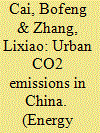| Srl | Item |
| 1 |
ID:
111353


|
|
|
|
|
| Publication |
2012.
|
| Summary/Abstract |
This study has proposed a new solution concerning fuel consumption in China's transport sector, which has provided a more accurate basis for estimating CO2 emissions in the transport sector both on national and regional level. Our analysis indicated that CO2 emissions in China's transport sector in 2007 reached to 436 Mt, higher than 408 Mt estimated by IEA. The CO2 emissions in transport sector accounted for 7% of China's total fossil fuel combustion CO2 emissions, which is much lower than the global average level of 23%. The CO2 emission from road transportation was 376.6 Mt, 37% higher than IEA's estimation. Therefore we thought IEA significantly underestimated the amount of CO2 emissions from road transportation in China, inevitably they overestimated CO2 emissions in other transportation means. The IEA's result of road transportation CO2 emissions is only 67.64% in the entire transport sector, but our study showed this ratio could be up to 86.32%. This study also preliminarily analyzed the driving-forces of CO2 emissions in transport sector at regional level. The results showed that the CO2 emissions in transport sector are closely associated with GDP. Finally the article had reviewed some policies in China's transport sector.
|
|
|
|
|
|
|
|
|
|
|
|
|
|
|
|
| 2 |
ID:
128033


|
|
|
|
|
| Publication |
2014.
|
| Summary/Abstract |
Different names/concepts and therefore different spatial boundaries for cities in China are responsible for the conflicting and confusing results associated with urban CO2 emissions accounting. In this study, four types of urban boundaries, i.e., city administrative boundary (UB1), city district boundary (UB2), city built-up area (UB3) and urban proper (UB4), were identified and defined. Tianjin was subsequently selected as the case city to illustrate the different performances of CO2 emissions with respect to these four boundaries using a 1-km grid dataset built bottom-up by point-emission sources. Different urban boundaries can induce a difference in CO2 emissions as large as 654%. UB1 and UB2 are not the appropriate proxies for urban boundaries in the analysis of urban CO2 emissions, although UB1 is a widely adopted boundary. UB3 is a good representative of city clusters and urban sprawl in a certain region, whereas UB4 is the appropriate system boundary for such issues as urban CO2 emissions in light of landscape characteristics and pertinent human activities, as well as the comparability to counterparts in developed countries. These results provide sound policy implications for the improvement of urban energy management and carbon emission abatement in China.
|
|
|
|
|
|
|
|
|
|
|
|
|
|
|
|